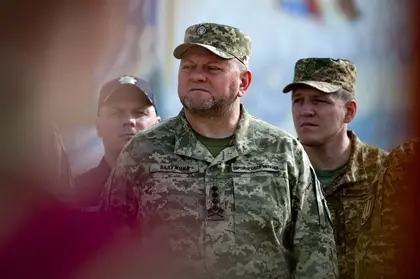Valery Zaluzhny, the head of Ukraine's Armed Forces, voiced his concerns in an interview with The Economist, highlighting that the situation on the frontline has hit a point of stagnation.
He pointed out that there's a huge risk of the ongoing Ukrainian offensive transitioning into a prolonged static conflict that could extend over many years.
JOIN US ON TELEGRAM
Follow our coverage of the war on the @Kyivpost_official.
Read the highlights of the interview below:
1) ‘There will most likely be no deep and beautiful breakthrough’
Zaluzhny said that the situation on the front lines has "reached a deadlock". He warned that the ongoing Ukrainian offensive is at risk of evolving into a protracted positional warfare that could extend for years.
“There will most likely be no deep and beautiful breakthrough,” he said.
“Just like in the First World War we have reached the level of technology that puts us into a stalemate,” he added.
General Zaluzhny's perspective is gloomy, as he believes a significant technological breakthrough is needed to change the situation and he doesn't anticipate any rapid or substantial advancements.
2) Russia can't be stopped simply by 'bleeding' its troops
The Commander-in-chief of the Armed Forces of Ukraine acknowledged that there was an error in assuming that Russia could be deterred by inflicting casualties on its troops.
“That was my mistake. Russia has lost at least 150,000 dead. In any other country, such casualties would have stopped the war.”
He went on to suggest that life holds a different value in Russia and that Vladimir Putin is employing strategies reminiscent of combat tactics seen during the First and Second World Wars.

NATO, Ukraine to Meet Tuesday Over Russian Missile Strike
3) 'Four months should have been enough time for us to have reached Crimea'
Zaluzhny pointed out that the offensive plans of the Ukrainian Armed Forces had initially anticipated a rapid advancement of 30 kilometres per day, with the aim of overcoming Russian defensive lines.
"If you refer to NATO textbooks and our initial calculations, it should have taken us just four months to reach Crimea, engage in combat, withdraw from Crimea, and re-enter and exit the region," the commander-in-chief quoted as saying by the Economist.
However, as The Economist reported, the Ukrainian army, equipped with Western technology, finds itself mired in minefields while facing the onslaught of Russian artillery and drone attacks instead.
“First I thought there was something wrong with our commanders, so I changed some of them. Then I thought maybe our soldiers are not fit for purpose, so I moved soldiers in some brigades,” says General Zaluzhny.
However, it didn't make any substantial difference.
4) 'I realised that is exactly where we are [World War I]'
After the reshuffle in the military command did not give any result, he ordered his subordinates to find a book by Soviet Major General Pavel Smirnov, "Breakthrough of fortified defence Lines" in 1941, which analyzed the battles of the First World War.
“And before I got even halfway through it, I realised that is exactly where we are because, just like then, the level of our technological development today has put both us and our enemies in a stupor,” Zaluzhny said.
“The simple fact is that we see everything the enemy is doing and they see everything we are doing. In order for us to break this deadlock, we need something new, like the gunpowder which the Chinese invented and which we are still using to kill each other,” he added.
According to his assessment, the Ukrainian military is in dire need of advancements in drone technology, electronic warfare capabilities, and equipment for clearing mines, including the integration of innovative robotic solutions.
“It is important to understand that this war cannot be won with the weapons of the past generation and outdated methods,” Zaluzhny insisted. “They will inevitably lead to delay and, as a consequence, defeat.”
However, General Zaluzhny noted that there are no indications of an imminent technological breakthrough in these areas.
5) 'The attritional trench war can wear down the Ukrainian state'
Given that a technological breakthrough is not expected in the near future, the Ukrainian army can only continue the offensive, maintaining the initiative in order not to allow the war to become positional, Zaluzhny said.
“The biggest risk of an attritional trench war is that it can drag on for years and wear down the Ukrainian state,” he says.
“We need to look for this solution, we need to find this gunpowder, quickly master it and use it for a speedy victory. Because sooner or later, we are going to find that we simply don’t have enough people to fight.”
Earlier, The Economist published an article by Zaluzhny, in which he stated that the war between Russia and Ukraine is moving towards a stalemate with grueling battles.
You can also highlight the text and press Ctrl + Enter






